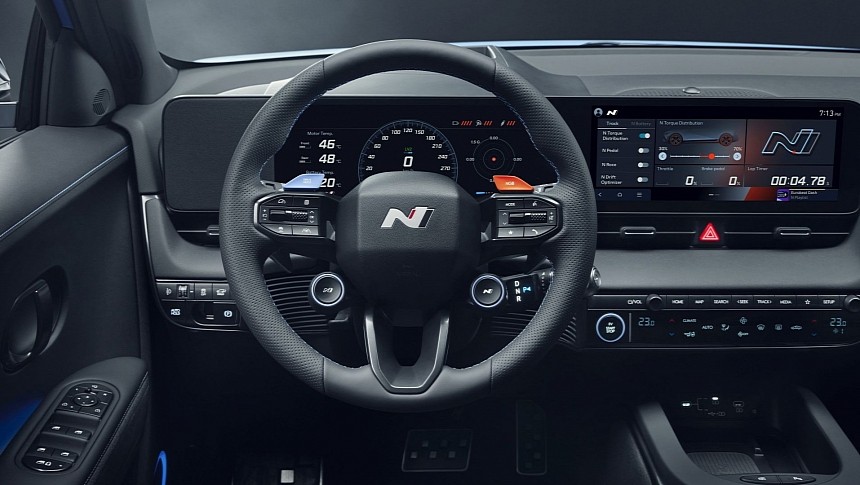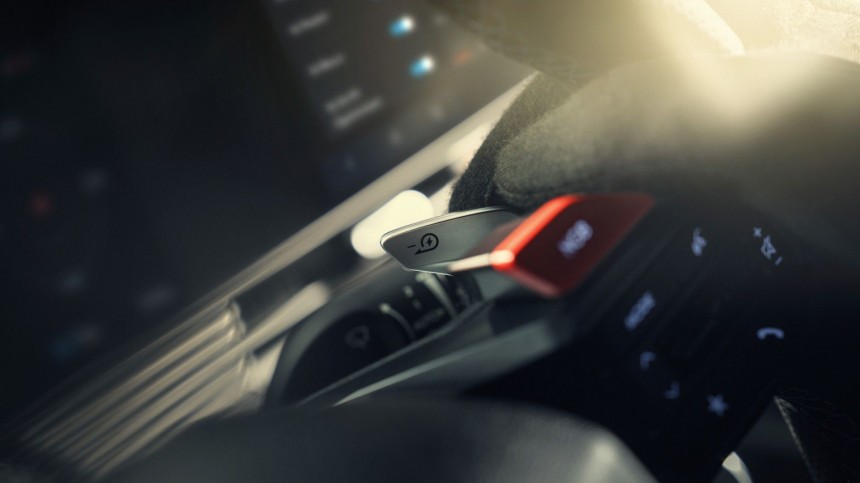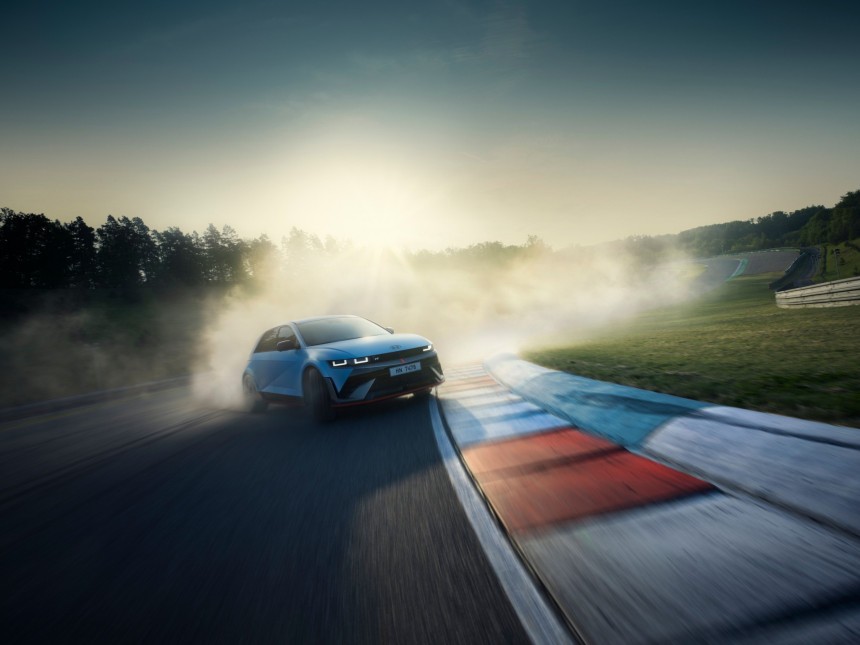Hyundai has just presented its most powerful car ever at the Goodwood Festival of Speed. It is also the first battery electric vehicle (BEV) to wear the N badge. All these things should make the IONIQ 5 N a remarkable car. Yet, it is also the latest example that legacy automakers think BEVs are boring. For them to be really engaging, these companies believe they have to mimic an internal combustion-engined (ICE) vehicle.
In the IONIQ 5 N's case, that can be seen in two features the BEV offers: N e-shift and N Active Sound+. You may have already heard about them in the thousands of stories that were written about the new Hyundai, but allow me to clarify that to the readers who may have no idea what those things are.
The N e-shift is a simulacrum of an eight-speed dual-clutch gearbox. You'll find the famous paddle shifters behind the steering wheel – in the same position you'd find them in an ICE car. When you move them to "shift gears," the car will react as if it really had the dual-clutch transmission by "controlling motor torque output" and simulating "the jolt feeling between shifts." Hyundai said it "provides a more precise, interactive driving experience that feels closer to ICEs (sic) than previous EVs." In the end, what the Korean carmaker is saying is that only ICE vehicles can offer a "more precise, interactive driving experience."
To make matters worse, Hyundai also offers the N Active Sound+ – what is the deal with calling everything "N whatever," a Batman syndrome? This system uses ten speakers to make the IONIQ 5 N sound like something other than a BEV. With the "Ignition" theme, you get the feeling you are driving an i30 N. You probably have never heard the Hyundai RN22e working – check the video embedded below for a tiny idea – but that's what you get if you select the "Evolution" theme. To be honest, it is something "inspired" by the RN22e, which means it can sound like anything. Finally, the "Supersonic" theme tries to make the electric SUV remind you of a twin-engine fighter jet. It makes you wonder who will crave that instead of feeling embarrassed to use these systems. Luckily, they are easy to turn off.
In the 2000s, Chinese companies sold what was nicknamed "virtual turbo." This gadget would make any vehicle emit a sound that was similar to the blow-off valve whistle you get when you lift your foot from the gas pedal. In other words, it made your car seem to be turbocharged. That soon became a joke among car enthusiasts because the vehicles that used the "virtual turbo" did not present a performance that matched the noise: it was shamefully fake. At least the IONIQ 5 N delivers 478 kW (641 hp), but that does not make the phony gearbox and the bogus sounds less unnecessarily artificial.
Anyone looking for gear-shifting reactions and engine roars can still buy an ICE sports car. Even Hyundai sells nice alternatives to an electric sports car for those who are seeking what is usually associated with high performance. Supposing they really end up forbidden as new vehicles – as it seems developed countries will soon implement – used ones will still be around, some of them with musical V8s, V10s, and V12s. BEVs are different animals. Having them pretend to have engines and transmissions is like taking a whale for a fish – or trying to make a seagull sound like a hawk.
What Hyundai did with the IONIQ 5 N reminds me of an RC Lancia Stratos I had when I was a kid. It sounded as if it had a combustion engine. I knew it used batteries, but I confess I was disappointed when I dismantled it and discovered the sound came from a tiny drum activated by a gear installed in the rear axle. It was as artificial as what Hyundai's high-performance BEV now presents, but that is not what bugs me the most about it.
Considering the work the Hyundai N division engineers put into this car, I cannot believe their only way to make it more attractive was with these gimmicks. It seems that instant torque and brisk acceleration are not enough to compensate for massive weight, lack of noise, and limited range – particularly if you are driving the IONIQ 5 N hard on a track. Hyundai even increased the IONIQ 5's battery pack to avoid that, but this also made the N derivative heavier. The Korean automaker did not even disclose how much weightier it is.
What if engineers had the liberty to create a BEV that was thrilling in its own fashion? I have no idea what they could do, but imagine it was possible to give a motor turning at 21,000 rpm a peculiar sound. Would the marketing department allow them to pursue that instead of making them develop the ridiculous Bat tricks – sorry, N gizmos – that only scream an electric car fundamentally lacks whatever makes a vehicle exciting? We already know this is not true, but this is the idea the IONIQ 5 N reinforces. It identifies as an ICE vehicle to try to be accepted as a legitimate fast car. Ironically, that's something it already is: there's no need for make-believe. Yet, here we are.
It may eventually happen that we realize we need something other than batteries to have a high-performance electric car – or better cells that are yet to be developed. Having something fast that weighs more than two tons is scary, particularly if the brakes fail for any reason. While we do not get there, we should at least have the decency of allowing BEVs to be what they are. Forcing them to pretend to be something they are not implies one of two things: either they should be fundamentally different or should not exist. Any of these hypotheses will seem conflicting if you are trying to sell such vehicles. Whether you want to do that or not will not matter, but it will be easy to tell if you are doing that because you bought the idea or just because you have to.
The N e-shift is a simulacrum of an eight-speed dual-clutch gearbox. You'll find the famous paddle shifters behind the steering wheel – in the same position you'd find them in an ICE car. When you move them to "shift gears," the car will react as if it really had the dual-clutch transmission by "controlling motor torque output" and simulating "the jolt feeling between shifts." Hyundai said it "provides a more precise, interactive driving experience that feels closer to ICEs (sic) than previous EVs." In the end, what the Korean carmaker is saying is that only ICE vehicles can offer a "more precise, interactive driving experience."
To make matters worse, Hyundai also offers the N Active Sound+ – what is the deal with calling everything "N whatever," a Batman syndrome? This system uses ten speakers to make the IONIQ 5 N sound like something other than a BEV. With the "Ignition" theme, you get the feeling you are driving an i30 N. You probably have never heard the Hyundai RN22e working – check the video embedded below for a tiny idea – but that's what you get if you select the "Evolution" theme. To be honest, it is something "inspired" by the RN22e, which means it can sound like anything. Finally, the "Supersonic" theme tries to make the electric SUV remind you of a twin-engine fighter jet. It makes you wonder who will crave that instead of feeling embarrassed to use these systems. Luckily, they are easy to turn off.
Anyone looking for gear-shifting reactions and engine roars can still buy an ICE sports car. Even Hyundai sells nice alternatives to an electric sports car for those who are seeking what is usually associated with high performance. Supposing they really end up forbidden as new vehicles – as it seems developed countries will soon implement – used ones will still be around, some of them with musical V8s, V10s, and V12s. BEVs are different animals. Having them pretend to have engines and transmissions is like taking a whale for a fish – or trying to make a seagull sound like a hawk.
What Hyundai did with the IONIQ 5 N reminds me of an RC Lancia Stratos I had when I was a kid. It sounded as if it had a combustion engine. I knew it used batteries, but I confess I was disappointed when I dismantled it and discovered the sound came from a tiny drum activated by a gear installed in the rear axle. It was as artificial as what Hyundai's high-performance BEV now presents, but that is not what bugs me the most about it.
What if engineers had the liberty to create a BEV that was thrilling in its own fashion? I have no idea what they could do, but imagine it was possible to give a motor turning at 21,000 rpm a peculiar sound. Would the marketing department allow them to pursue that instead of making them develop the ridiculous Bat tricks – sorry, N gizmos – that only scream an electric car fundamentally lacks whatever makes a vehicle exciting? We already know this is not true, but this is the idea the IONIQ 5 N reinforces. It identifies as an ICE vehicle to try to be accepted as a legitimate fast car. Ironically, that's something it already is: there's no need for make-believe. Yet, here we are.
It may eventually happen that we realize we need something other than batteries to have a high-performance electric car – or better cells that are yet to be developed. Having something fast that weighs more than two tons is scary, particularly if the brakes fail for any reason. While we do not get there, we should at least have the decency of allowing BEVs to be what they are. Forcing them to pretend to be something they are not implies one of two things: either they should be fundamentally different or should not exist. Any of these hypotheses will seem conflicting if you are trying to sell such vehicles. Whether you want to do that or not will not matter, but it will be easy to tell if you are doing that because you bought the idea or just because you have to.























